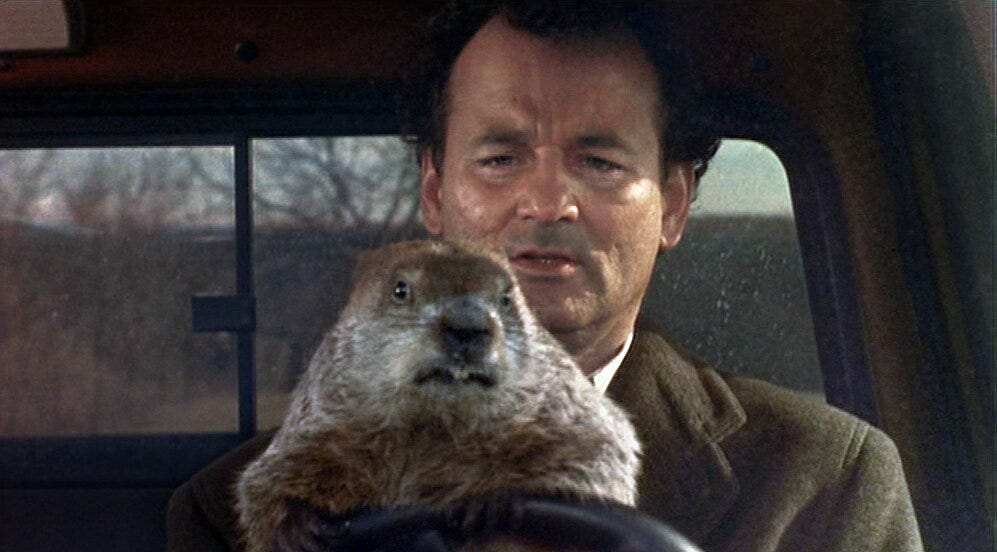
*Author’s Note: This was originally published on RealClear Religion, here.
The 1993 classic Groundhog Day is one of the best depictions of Purgatory in any art form, alongside Dante Alighieri’s Purgatorio, the second chapter in the Italian poet’s Divine Comedy.
Now a film that features a rodent named Punxsutawney Phil, small-town folks (some obsessed with WrestleMania), blood sausage, Sonny and Cher’s “I’ve Got You Babe” and a character known as “Needle-Nose” Ned Ryerson may not, on paper, appear to rival the complexity and gravity explored on the path Dante’s Pilgrim treks. Yet the movie transcends its romantic comedy genre into an investigation of the soul, fate and purification, much like the 14th century epic poem.
To start, comparing Bill Murray’s Phil Connors — a weatherman for a Pittsburgh news-station — to Dante’s Pilgrim is certainly not a unique perspective. In fact, many others, like this great review written by Jonah Goldberg back in 2005, offer deep insights into the film’s spirituality beyond its Christian themes. However, debates over Purgatory’s existence have divided Christians since the Reformation, and even this author has had to field questions in recent years.
So, what is purgatory? The Catechism of the Catholic Church offers this definition: “All who die in God’s grace and friendship, but still imperfectly purified, are indeed assured of their eternal salvation; but after death they undergo purification, so as to achieve the holiness necessary to enter the joy of heaven” (1030). However, Purgatory is unique in that it is the only spiritual realm that will end, unlike the eternity of Hell or Heaven.
Even in Purgatorio, those souls who the Pilgrim converses with understand this truth, even as they toil in the purification process. There is joy in purgatory, knowing that entering God’s company is imminent as they ascend the mountain while shedding sins of pride, envy, wrath, sloth, greed, gluttony and lust. Purgatory, therefore, is not Hell-lite as non-Catholics might assume; it is a gift of God’s mercy — a chance to become perfect as He is perfect.
Groundhog Day’s Purgatory is not strictly dogmatic Catholic teaching, but it is more digestible than Purgatorio. Nevertheless, Connors takes a similar pilgrimage to Dante’s Pilgrim.
At the beginning of the movie, Connors is tired of shlepping to Punxsutawney, Penn., to cover the oldest “Groundhog Day” tradition for the fourth consecutive year. His elitist attitude toward the town’s residents knows no bounds, treating them as annoyances he avoids or shrugs off — like an elderly, homeless man — lest his notoriety suffer since a “major network” is interested in hiring him. Initially, every aspect of his existence is self-serving, even his attraction toward Rita, his TV producer played by Andie MacDowell. As he tries wooing her, nothing is truly genuine at first, as he uses the time loop to learn French poetry and her favorite ice cream flavor to manipulate her emotions. Nothing is beyond himself because Connors does not know how to truly love.
But no matter what Connors does, Rita rejects him. Hopeless, Conners kills himself in numerous ways, but he still wakes up on February 2, Groundhog Day, “without a dent in the fender” to radio disc jockeys excitedly shouting “rise and shine woodchuck chuckers!” And he endures the Punxsutawney natives in the seemingly endless loop, one that some estimate lasting 30 or more years.
Purgatory is not timeless, though. Yet we cannot fool God of our love for Him, like Connors cannot fool Rita. At the end of Purgatorio, Dante’s Pilgrim must demonstrate this trust in God by walking through fire and confessing his sins to his love, Beatrice. Similarly, Connors must show love by embodying the corporal works of mercy, including catching a kid falling from a tree, changing old ladies’ tires, performing the Heimlich maneuver on Buster (who is in charge of the Groundhog Day festivities) and even helping Ned Ryerson’s insurance business. He eventually utilizes his knowledge of Punxsutawney not because he believes doing so will help him break the time loop; but he willingly chooses to be a merciful, guardian angel, even if the residents will fall into the same trappings on the “next” February 2 (like he says, "I'll see you tomorrow, maybe").
In the end, Connors treats the residents not as annoyances, but as other souls on a similar pilgrimage to his own. It makes one wonder: why was Connors chosen to experience this phenomenon? Why did God allow Dante’s Pilgrim to journey through Hell, Purgatory and Heaven? Or, in real life circumstances, why does God choose the saints and how is he calling us to choose Him? Simply put, to show us His love for us.
The protagonists in Groundhog Day and Purgatorio come to the realization of love’s true, sacrificial nature. Purgatory is merely a step toward discovering God’s love for us. It allows for our transcendence and even transfiguration, casting away our sinful ways and egos. But it is not an easy road, as demonstrated in Connors’ and the Pilgrim’s journeys. After all, we are not promised easy lives when following Christ.
However, once we experience Purgatory, and cross the threshold into Heaven as purified souls, it makes the next step all the more awe-inspiring, and us more grateful to have endured the merciful penance — like Connors' utter joy when the long-awaited February 3rd finally arrives.
At the same time, Catholics are called to pray for the dead and the souls in purgatory. So, if you’re reading this, I hope you offer up a prayer to hasten someone’s journey to join God for all eternity.



Enjoyed the article and all your articles, even Milford City Council Meetings. Being a New Jersey resident , it looks the the kind of stuff we have thanks to Mr. Murphy.
I try to watch "Groundhogs Day" every year. God Bless.